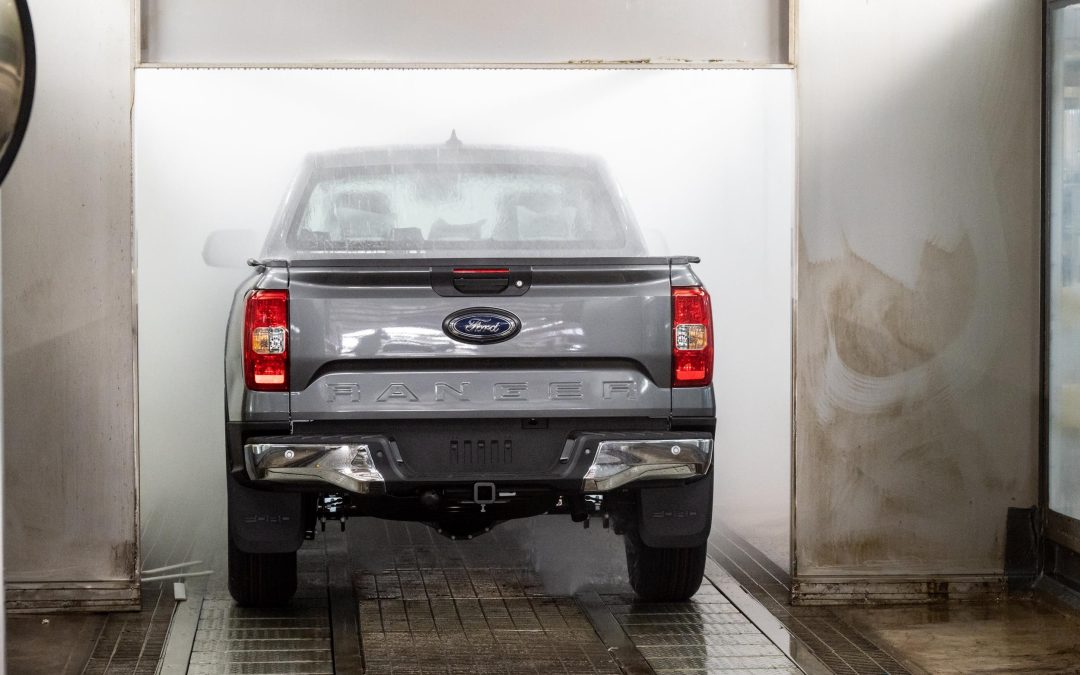The summer rainfall season brings a welcome respite from the heat, but it also transforms roads into potential hazards, forcing many motorists to face unpredictable conditions when heavy rains hit. After all, 75 percent of vehicle crashes caused by weather conditions occur on wet roads, with 47 percent happening during rainfall1.
“Many drivers will take great precautions when heading off-road, or driving in snow or sleet, but they don’t often give rain the same amount of respect,” said Derek Kirkby, Training Director at MasterDrive, which runs Driving Skills For Life for Ford in South Africa.
While driver awareness is paramount when driving in bad weather, Ford vehicles are also rigorously tested for water resistance to ensure they can handle stormy weather. The grueling Leak Test is intended to simulate the worst downpour imaginable to ensure Ranger and Ranger Raptor’s seals are watertight. As each vehicle rolls off the production line it’s sprayed with water from every angle for five minutes.
Here’s how it works:
- Rainstorm replication: High-pressure water jets blast the vehicle from every angle for a full five minutes, mimicking the relentless force of a monsoon downpour.
- Water tightness inspection: Auditors meticulously inspect the vehicle’s taillights, headlamps, and fog lamps, ensuring no water has penetrated the seals. Every door is opened, and rubber seals are carefully checked for any signs of water ingress.
- Water recycling: The water used in the test is collected, treated, and reused for subsequent tests, in line with Ford’s sustainability practices.
This test is crucial in ensuring your Ford vehicle can keep you nice and dry when driving in the rain, but being safe when driving in wet weather is more than just about staying dry.
Here are some essential tips on wet weather driving:
- Visibility is key: Make sure your wipers are in top condition and turn on your headlights, even during the day. Defog your windshield and rear windows for maximum visibility.
- Check your tyres: Your vehicle’s tyres are its only contact with the road, so making sure they’re inflated to the manufacturer’s recommended pressure and have enough tread is vital. If you’re not sure they’re at the correct pressure, then look for a label inside one of the front door openings or check your owner’s manual. Some Ford vehicles have a Tyre Pressure Management System which will alert you if it detects that any one of your vehicle’s tyres has lost pressure.
- Avoid using cruise control: While helpful on dry roads, cruise control can be risky in the rain. If your tyres lose traction, the system may continue accelerating to maintain speed, increasing the chance of skidding. By manually controlling your speed, you can react more effectively to slippery conditions.
- Slow down and brake smoothly: Driving in wet weather increases overall vehicle stopping distance. Always keep a safe enough distance so that you can stop in time.
- Maintain pedestrian awareness: Visibility is reduced when driving in the rain and because pedestrians are keen to avoid getting wet, they can often make hurried and unplanned road crossings.
- Avoid puddles and flood waters: Don’t underestimate the dangers of driving through potholes and stagnant waters. If you can’t avoid it, make sure you slow down to reduce the risk of damage to your vehicle. Hitting potholes or flooded waters at speed can damage your vehicle’s wheel or even knock the suspension and steering out of alignment.
- Beware of standing water: Standing water can hide hazards and lead to aquaplaning, where your tyres lose contact with the road surface. If you experience aquaplaning, gentle ease off the accelerator, avoid sudden braking or steering, and regain control before proceeding.
- Avoid tailing and overtaking: Tailing and overtaking in wet conditions is inherently risky, especially when you’re around larger vehicles like buses or trucks that have a much larger spray zone and could obstruct your vision.
- Know when to stop: If you can no longer see the edges of the road or you can’t clearly see other vehicles at a safe distance, then stop and reassess your situation. Pick a safe spot to stop and wait out the storm as everyone else’s visibility will also be drastically reduced.
- Have an emergency wet weather kit: Summer rains can cause roads to flood quickly, making it easy to become stranded. So, ensure you have a wet weather kit in your vehicle, containing things like a raincoat and umbrella, a waterproof torch, some fresh water, snacks, and maybe even a change of clothes in case you get wet.
Disclaimers
1 https://goldbergloren.com/weather-related-accident-statistics/


